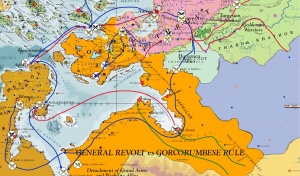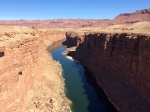Difference between revisions of "Main Page"
Trismegistus (talk | contribs) m |
Trismegistus (talk | contribs) m |
||
| Line 39: | Line 39: | ||
| style="color:#000;" | <div id="mp-tfa" style="padding:2px 5px"> | | style="color:#000;" | <div id="mp-tfa" style="padding:2px 5px"> | ||
| − | [[File: | + | [[File:FifthGeddaminWar_Campaigns_MemnosianTheater_01.jpg|thumb|300px|Major Campaigns in the Memnosian Theater]] |
| − | The | + | The last of the [[Geddamin Wars]], the Fifth Geddamin War last from 2582 to 2586. It marked the end of [[Gorcorumb]]ese aspirations to retain and expand their great empire. Allied humans captured [[titancraft]] vessels from Geddamin and as a consequence began the development of [[titancraft]] technology. Due the outcome of the [[Great Sky War]], [[Gorcorumb]] lost its greatest ally with the defeat and reduction of the [[New Kalikán Empire]]. As [[Aurice]] was no longer subject to Gorcorumb's former ally, the Gorcorumbese Giants waged war a new offensive against the east, hoping to defeat the newly arisen Aurician Empire of [[House Bijäl]]. The Fifth Geddamin War arose soon after the truce that ended the [[Fourth Geddamin War]]. The [[Aurician Empire]] and her allies defeated the [[Gorcorumb]]ese and commenced a period of military, political, and cultural magnificence. |
| − | + | Gorcorumb's aspirations were greatly to perish. Gorcorumbese Empire lost all extra-Danonan Territory, except Desthor, and the Gorcorumbese Empire waned steadily after this war. Mainland Corundy was liberated with the aid of Aurice under the leadership of the powerful [[Grand Duke Stalcast Bijäl]]. This help from Aurice enhanced Aurice's reputation. Nations and Tribes of northwest Weshif had a general revolt and Gorcorumb was not able to recover them. Aurice did not retain or occupy Corundy after the war, unlike her dominion of the two provinces of Zamir. Aurice gained much prestige and political clout and her acquisition of titancraft technology began the transformation of her military engine into an imperial force with repercussions for her overseas colonies and for her domination of western Asdauria in the 27th century. ([[Fifth Geddamin War|Full Article]]...) | |
|- | |- | ||
| Line 80: | Line 80: | ||
| style="padding:2px;" | <h2 id="mp-itn-h2" style="margin:3px; background:#cedff2; font-size:120%; font-weight:bold; border:1px solid #a3b0bf; text-align:left; color:#000; padding:0.2em 0.4em;">Featured Pictures </h2> | | style="padding:2px;" | <h2 id="mp-itn-h2" style="margin:3px; background:#cedff2; font-size:120%; font-weight:bold; border:1px solid #a3b0bf; text-align:left; color:#000; padding:0.2em 0.4em;">Featured Pictures </h2> | ||
|- | |- | ||
| − | | style="color:#000; padding:2px 5px;" | <div id="mp-itn"> [[File: | + | | style="color:#000; padding:2px 5px;" | <div id="mp-itn"> [[File:CanyonoftheShedu.jpg|left|thumb|150px|Photograph of the [[Leh-Shelekhumbis River]] flowing through the Canyon of the Shedu in the southwestern [[Adamantine Mountains]] ]] |
| − | + | The river passes through the evocative [[Canyon of the Shedu]] shortly before it descends from the [[Adamantine Mountains]] into the [[Susurrant Desert]]. The small settlement of [[Kishkelumadh]], the site of an important [[Hamagnostic]] monastery, rests to the north of the river. Important sites along the river include [[Ori]], [[Shakhrilim]], [[Gegdolissi]], [[Tandhigumi]], [[Makhutolib]], [[Elántuventh]], and [[Lumajat]]. ([[Leh-Shelekhumbis River|Full Article]]...) | |
| − | [[File: | + | [[File:JahmatSketch.jpg|left|thumb|100px|The obelisk-shaped monument known as a [[Jahmat]] is found in the thick jungles of [[Bahuna]] ]] |
| − | + | Also known as the pyramids of Zephasia, the Jahmat are mysterious and colossal structures thought to have been created by the very ancient Titans who dwelt in Zephasia some twenty five thousand years ago or more. The word 'jahmat' is a Zephasian word and is both singular and plural in common usage. ([[Jahmat|Full Article]]...) | |
</div> | </div> | ||
Revision as of 21:16, 7 October 2015
|
|
|
|
Other Resources
- World of Asdar Main Homepage This page is very minimal (2014 May 17)
- World of Asdar Blog begun 2014 May 17
- World of Asdar RPG Game begun 2015 September 19
- World of Asdar YouTube Channel
- Random Article
- Gallery of New Files
- Utility Page



